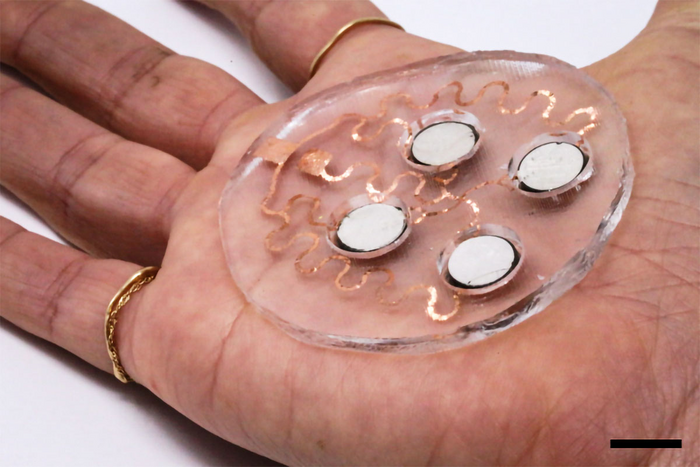Researchers in the US have developed a wearable patch that applies painless ultrasonic waves to the skin, creating tiny channels that drugs can pass through.
The approach could lend itself to delivery of treatments for a variety of skin conditions and could also be adapted to deliver hormones, muscle relaxants, and other drugs, the researchers say.
Canan Dagdeviren, an associate professor in MIT’s Media Lab and the senior author of the study, said:
“The ease-of-use and high-repeatability offered by this system provides a game-changing alternative to patients and consumers suffering from skin conditions and premature skin ageing.
“Delivering drugs this way could offer less systemic toxicity and is more local, comfortable, and controllable.”
The project began as an exploration of alternative ways to deliver drugs.
Most drugs are delivered orally or intravenously, but the skin could offer much more targeted drug delivery for certain applications.
MIT research assistant, Aastha Shah, said:
“The main benefit with skin is that you bypass the whole gastrointestinal tract.
“With oral delivery, you have to deliver a much larger dose in order to account for the loss that you would have in the gastric system.
“This is a much more targeted, focused modality of drug delivery.”
Ultrasound exposure can enhance the skin’s permeability to small-molecule drugs, but most of the existing techniques for performing this kind of drug delivery require bulky equipment.
The MIT researchers wanted to come up with a way to perform this kind of transdermal drug delivery with a lightweight, wearable patch, which could make it easier to use for a variety of applications.
They designed a device consisting of a patch embedded with several disc-shaped piezoelectric transducers, which can convert electric currents into mechanical energy.
Each disc is embedded in a polymeric cavity containing the drug molecules dissolved in a liquid solution.
As an electric current is applied to the piezoelectric elements, they generate pressure waves in the fluid, creating bubbles that burst against the skin.
The bursting bubbles produce microjets of fluid that can penetrate through the skin’s tough outer layer.
Author Amin Karami of the University of Buffalo, said:
“This works open the door to using vibrations to enhance drug delivery.
“There are several parameters that result in generation of different kinds of waveform patterns.
“Both mechanical and biological aspects of drug delivery can be improved by this new toolset.”
The patch is made of PDMS, a silicone-based polymer that can stick to the skin without tape.
The researchers tested the device by delivering a B vitamin called niacinamide, an ingredient in many sunscreens and moisturisers.
In tests using pig skin, the researchers found that when they delivered niacinamide using the ultrasound patch, the amount of drug that penetrated the skin was 26 times greater than the amount that could pass through the skin without ultrasonic assistance.
They also compared the results from their new device to microneedling, a technique sometimes used for transdermal drug delivery, which involves puncturing the skin with miniature needles.
They found that their patch was able to deliver the same amount of niacinamide in 30 minutes that could be delivered with microneedles over a six-hour period.
With the current version of the device, drugs can penetrate a few millimetre into the skin, making this approach potentially useful for drugs that act locally within the skin.
These could include niacinamide or vitamin C, which is used to treat age spots and other dark spots on the skin, or topical drugs used to heal burns.
The technique could also be used for drugs that need to reach the bloodstream, such as caffeine, fentanyl or lidocaine.
Dagdeviren also envisions that this type of patch could be useful for delivering hormones such as progesterone.
The researchers are now exploring the possibility of implanting similar devices inside the body to deliver drugs to treat cancer or other diseases.
They are also working on further optimising the wearable patch, in hopes of testing it soon on human volunteers.
Image: MIT




